Some readers may have spotted a third data series in the business outlook chart presented toward the conclusion of the preceding business transformation article that showed projected web traffic over a four-year transformation period. We didn't call out the traffic projection then, but resellers need to understand that this metric underlies the digital transformation. Without traffic, the strategy fails, period.
While this metric places the website at the foundation of the business transformation, resellers must also understand it can't just be any old website. It must be a site that conforms to a myriad of "rules" and provides a value-add experience for new and returning visitors.
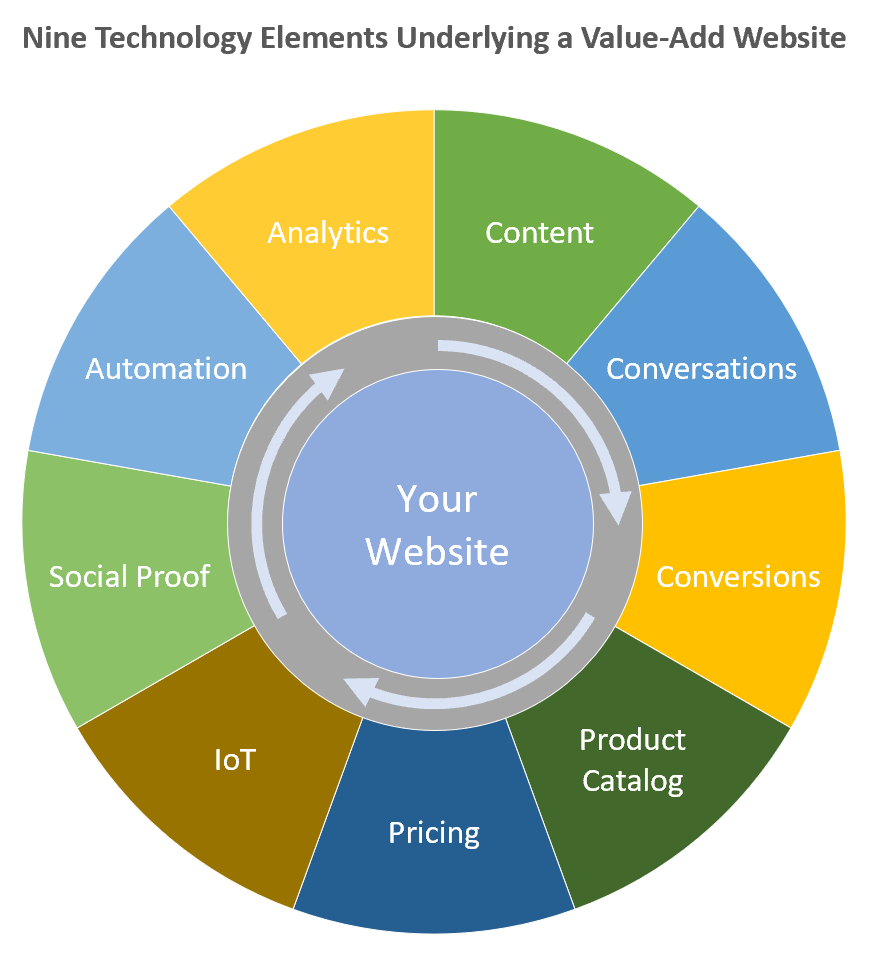
Content designed to educate relevant visitors about problems they may or may not even know they have. Content that's subtly created to dovetail into the reseller's value proposition.
Conversations are facilitated, encouraged, and recorded to CRM with a variety of options available to permit the user to select from their channel of choice, whether it is via email, web forms, chat, telephone, or instant messaging via social media.
Conversions are accomplished by seeking personal details from visitors once the right to ask for them has been earned and the visitor has developed sufficient trust to be comfortable providing them.
Product Catalog with open pricing available to browse without requiring registration or having to wait while an administrator sets up an account. Organized to promote the best customer value proposition and optimize the reseller's profits.
Pricing that reflects competitive market pricing for the channel the reseller is selling into whether it be B2B or B2C while avoiding the "margin-destroying" outcome of cost-plus pricing models.
Internet of Things capability provided for clients to adopt for improved efficiency and a reduced cost while also helping the reseller to reduce churn and improve its value proposition.
Social Proof includes testimonials, product and customer reviews, social audience, scope, and engagement (likes, etc.)
Automation by seamless updates to contact records as additional information is obtained and dynamic list segmentation facilitates marketing the right content to the right person at the right time.
Analytics are deployed to enable the reseller to fine-tune and promote its value proposition to its customers, as well as optimize its business model in terms of selling prices and costs to maximize its profits.
The immediate goal for a reseller in the current industry environment is to stabilize its existing business by reducing churn, then uncover opportunities for up-selling and cross-selling with existing customers, and then, ultimately, to start to win new customers. The foundation for achieving this is its website, and for it to fulfill this role, it must perform in terms of its effectiveness for developing relevant and sustainable traffic. It must also be fully integrated into the back-end systems to convert clicks and other activity into actionable business intelligence.
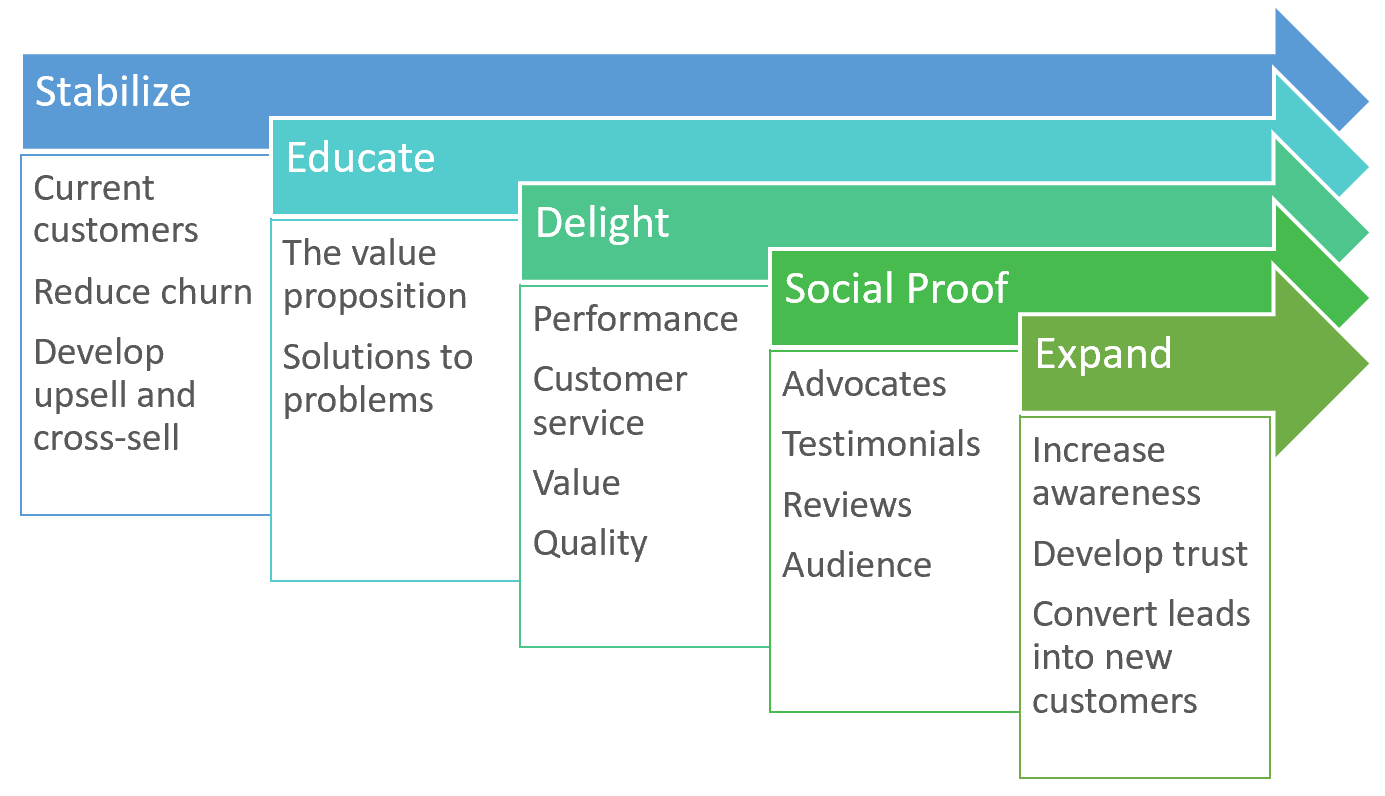
However, a key takeaway here is that a new website, in isolation, will not automatically lead to traffic and nor will it automatically lead to an increase in customer acquisition rates. As we have explained, even though it serves as the foundation for achieving these objectives, it's only one element in the overall suite of requirements. This means that after deploying a "rule-conforming" website, the initial focus must be on implementing tactics to win more business from existing customers while also knowing these tactics will be laying the foundation for future improvements in customer acquisition rates.
Improving the existing customer experience:
It's unlikely many of a reseller's existing customers frequently visit their current website because, usually, there's no value-add to be gained from doing so.
Customers must be provided a good reason to visit their reseller's website. This can be for:
- The purposes of an ongoing education related to the overall value proposition.
- Conducting a transaction.
- Accessing client-specific information such as order history or product availability, pricing, analytics, etc.
Whichever it is, it must be a positive experience, and it must add value from the perspective of the customer. Anything less and they just won't visit.
Over 70% of buyers now research online before they will engage with a salesperson. These researching buyers include existing customers so, a reseller who fails to provide content that's responsive to this research must understand this is likely to be one of the primary reasons why its customer churn rates are increasing.
The use of technology helps a reseller drive traffic to its website for a value-add experience.
While the website may be the foundation for a digital transformation, customer relationship management (CRM) software is the hub. This is where the accumulating data must be mapped and stored to develop actionable business intelligence.
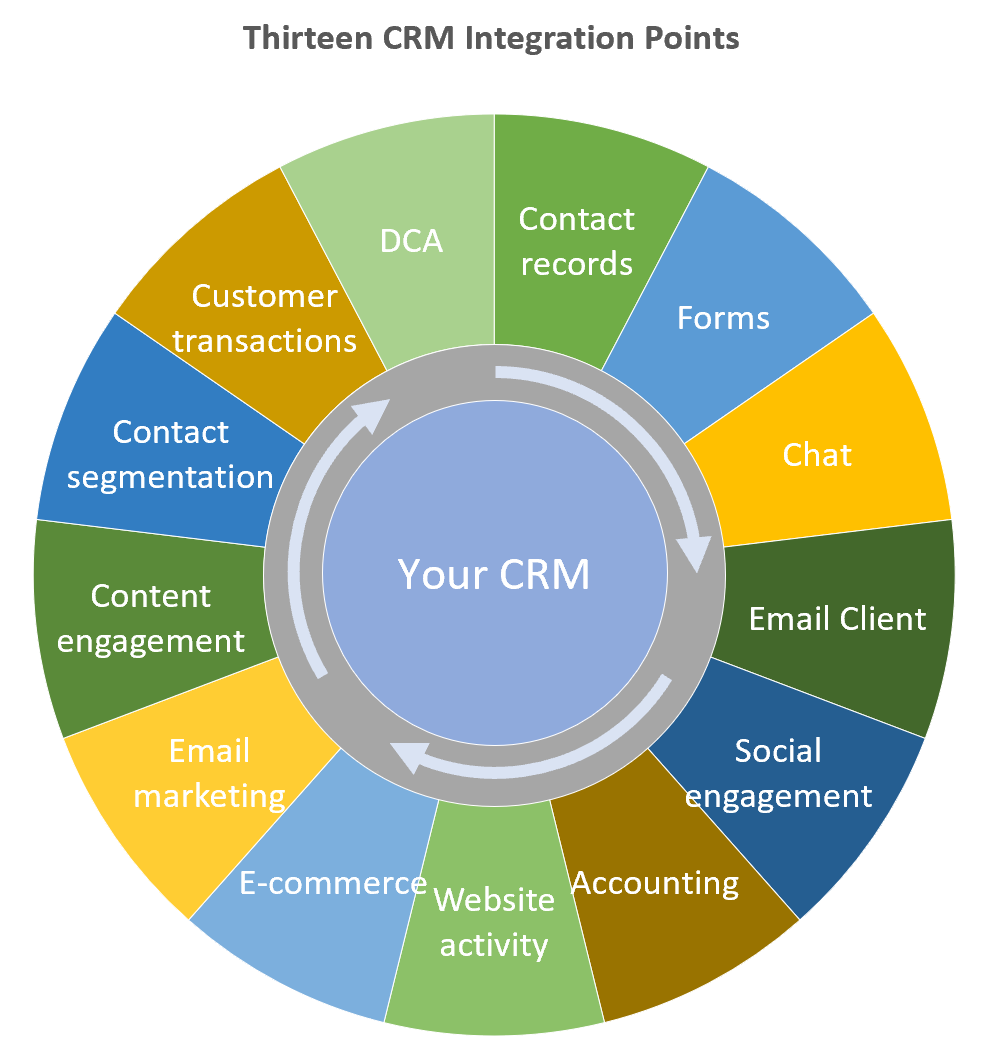 Contact records are the foundation within the foundation and make up the most important asset for the early stages of a digital transformation. Data accuracy is essential regarding spelling, email addresses, street addresses, phone numbers, titles, responsibilities, etc. This includes making sure the use of upper and lower case is appropriate. Remember, contact details will be used for email personalization, and misspelled or inappropriately capitalized names are jarring oversights that must be avoided. Finally, every contact must be assigned an "owner" responsible for managing the contact.
Contact records are the foundation within the foundation and make up the most important asset for the early stages of a digital transformation. Data accuracy is essential regarding spelling, email addresses, street addresses, phone numbers, titles, responsibilities, etc. This includes making sure the use of upper and lower case is appropriate. Remember, contact details will be used for email personalization, and misspelled or inappropriately capitalized names are jarring oversights that must be avoided. Finally, every contact must be assigned an "owner" responsible for managing the contact.
Forms on the website are designed for conversions, but they must be smart forms. If you already have the information from a previous form submission, then it's simple, don't ask for it again. Ask for something else that helps you learn more about the contact. Ensure each new form submission is integrated directly into the CRM and the contact owner is automatically notified about the activity.
Chat has become an important communication channel and must be deployed intelligently across targeted site pages. Different messages are displayed according to the content and objective of the page along with full integration to CRM for capturing transcripts, auto emailing them to contacts, automatically populating data fields in CRM as the contact profile continues to be built, and instantly notifying the contact owner of the activity.
Email client integration becomes another powerful element for measuring and notifying contact owners of engagement. Emails dispatched from the user's email system are copied automatically to the contact record in the CRM, email opens, link clicks, and file downloads are instantly recorded, and owners are notified.
Social engagement becomes another source of actionable business intelligence with integrated data flows to CRM advising contact owners of clicks, likes, follows, and other forms of engagement.
Accounting system integration is important for several reasons including maintenance of one set of common (accurate) customer and contacts records, but even more so for providing signals to the CRM system to quickly identify changes in customer procurement patterns and managing thresholds for launching product and vendor review requests as well as customer satisfaction surveys.
Website activity remains at the foundation of the overall strategy, so it's important to be monitoring the activities of visitors by recording clicks and other forms of engagement to the individual contact records in the CRM system. Collecting and leveraging the information gained about visitors from their page views, clicks, content downloads, etc., underlies the ability to target them with additional related and relevant content to continue the lead nurturing process.
E-commerce activity has taken on a life of its own, becoming a "vital sign" to gauge the health of many businesses threatened by the emergence of Amazon. However, mostly, these "vital signs" relate to retail, or B2C, commerce and are used to judge how businesses such as Best Buy, Walmart, etc., are responding to the threat. For most resellers though, it's not about B2C. Instead, it's all about B2B which may often require integrations to client systems alongside other features designed to eliminate customer friction points. A reseller's online portal must also be integrated with its CRM system to allow relevant transactional information to flow and become part of the shared knowledge base.
Email marketing will be the single most important element of the initial stages of the transformation because it will have the highest return on investment, building awareness and compensating for the lack of scale and engagement of social audiences and little to no web traffic. Email marketing must be fully integrated with the CRM system, leveraging accurate, dynamic contact records containing the latest information gathered from a contacts engagement history. It is this capability that will facilitate delivering highly targeted information, to the right person, at the right time.
Content engagement metrics provide valuable signals about the value the audience associates with the material that's being provided. Whether the content is accessed from social media, a blog, or via email marketing, the opens and clicks continually provide clues about the interests of the audience and the channel they prefer to engage from. These clues are all seamlessly incorporated into the contacts timeline helping the "owner" fine-tune the overall nurturing process.
Contact segmentation is one of the most important components of digital marketing and must not be compromised. Dynamic segmentation of contacts into small, highly focused "lists" cannot be accomplished cost-effectively with a manual process. This explains why it's important to integrate every system from which important signals can be gathered and use these signals to dynamically segment the lists within the contact database. This becomes the "magic" underlying the ability to deliver the right content to the right person at the right time.
Customer transactions are, ultimately, the lifeblood of a reseller, and their customers should be "intelligently" thanked for their business and "judicially" asked to occasionally leave a review of their reseller's performance. Again, this activity cannot be accomplished effectively with a manual process or with "dumb" automation. Sending a "thank-you" or "review" request out each time an order is processed may be appropriate for a client that orders once per month but completely inappropriate for one who orders multiple times per day. This means business activity thresholds must be established based on ordering patterns and volume and then used to trigger a "thank-you" or a "review" request. Ultimately, favorable reviews lead to testimonials, which help provide social proof potential new customers will be looking for evidence of before deciding to move forward.
A Data Collection Agent represents the gold standard in providing the capacity for collecting priceless information about the status of all the networked printing devices at customer locations. The data from the remote collection agent reports the printer's status and identifies when ink and toner supplies need to be replenished. The data can also be analyzed to determine overall running costs and help select lower-cost hardware and supplies alternatives at the optimal replacement time. This type of integration with customers is the foundation for getting ahead of the curve and helping to reduce the churn currently taking place to online competitors such as Amazon.
The complete technology package is necessary for a digital transformation.
As has been explained, and as can be seen from the images below, there are many components, and there are many moving parts. Because of the complexity, it can only be through integrated technology systems that it becomes possible to bring all these components together and then leverage an accumulation of data into actionable business intelligence.
Actionable business intelligence underlies improvements in the value proposition, helps turn existing customers into advocates, reduces churn, and makes it possible to improve customer acquisition rates to profitably grow a business.
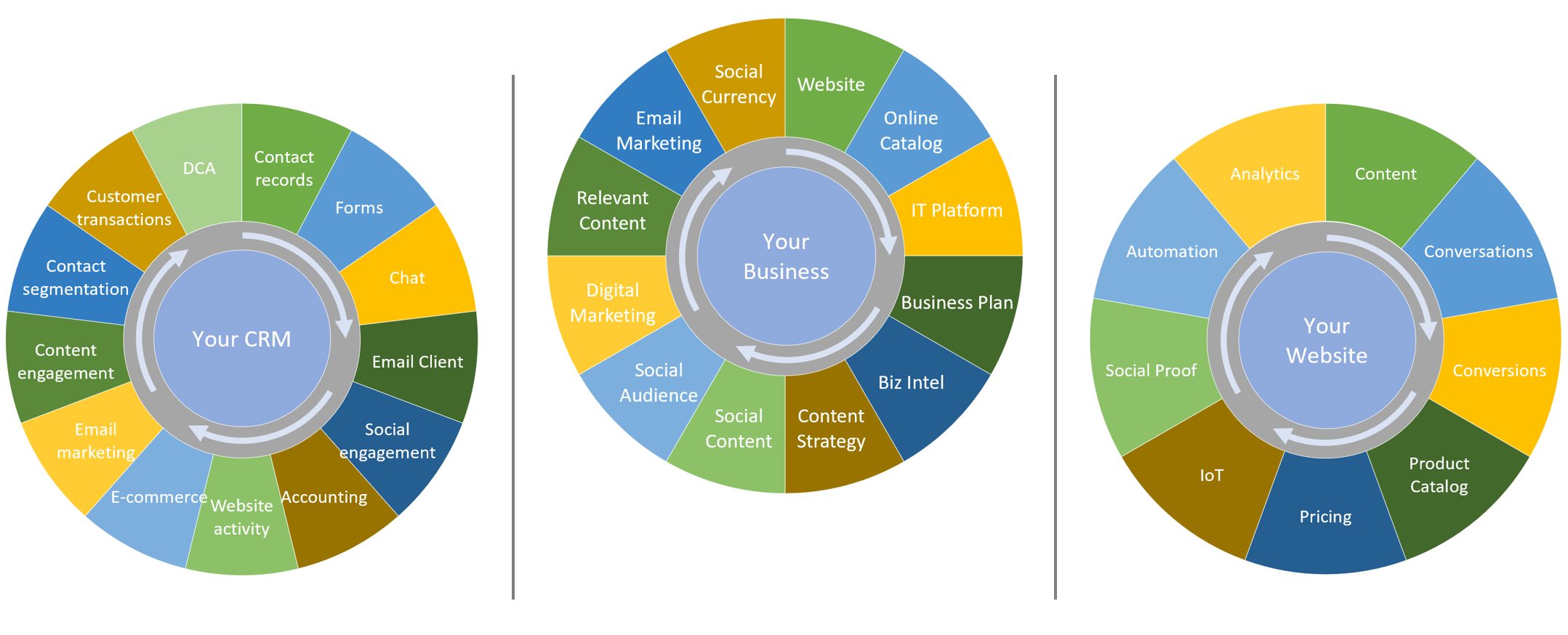
This leads us to circle back to our concluding point from the preceding business transformation article, that the reseller must be able to accomplish a quantifiable improvement in gross margin, an improvement that can be measured and that will help finance the transformation needed for it to thrive.
The use of technology to optimize sell prices, build the best possible value proposition, and to optimize the product and logistics costs, becomes possible when a reseller operates its business on a platform designed to deliver these objectives.
However, even this capability is unlikely to be sufficient to offset the full impact of typical churn rates, explaining why technology must be used in tandem with leading-edge digital marketing tactics.
The following chart stack illustrates three examples representing $2M, $5M, and $10M resellers. It highlights three key performance indicator improvements that become more likely when incorporating technology into the value proposition:
- Optimize sell prices and frequently update.
- Optimize product cost.
- Improve operational efficiency.
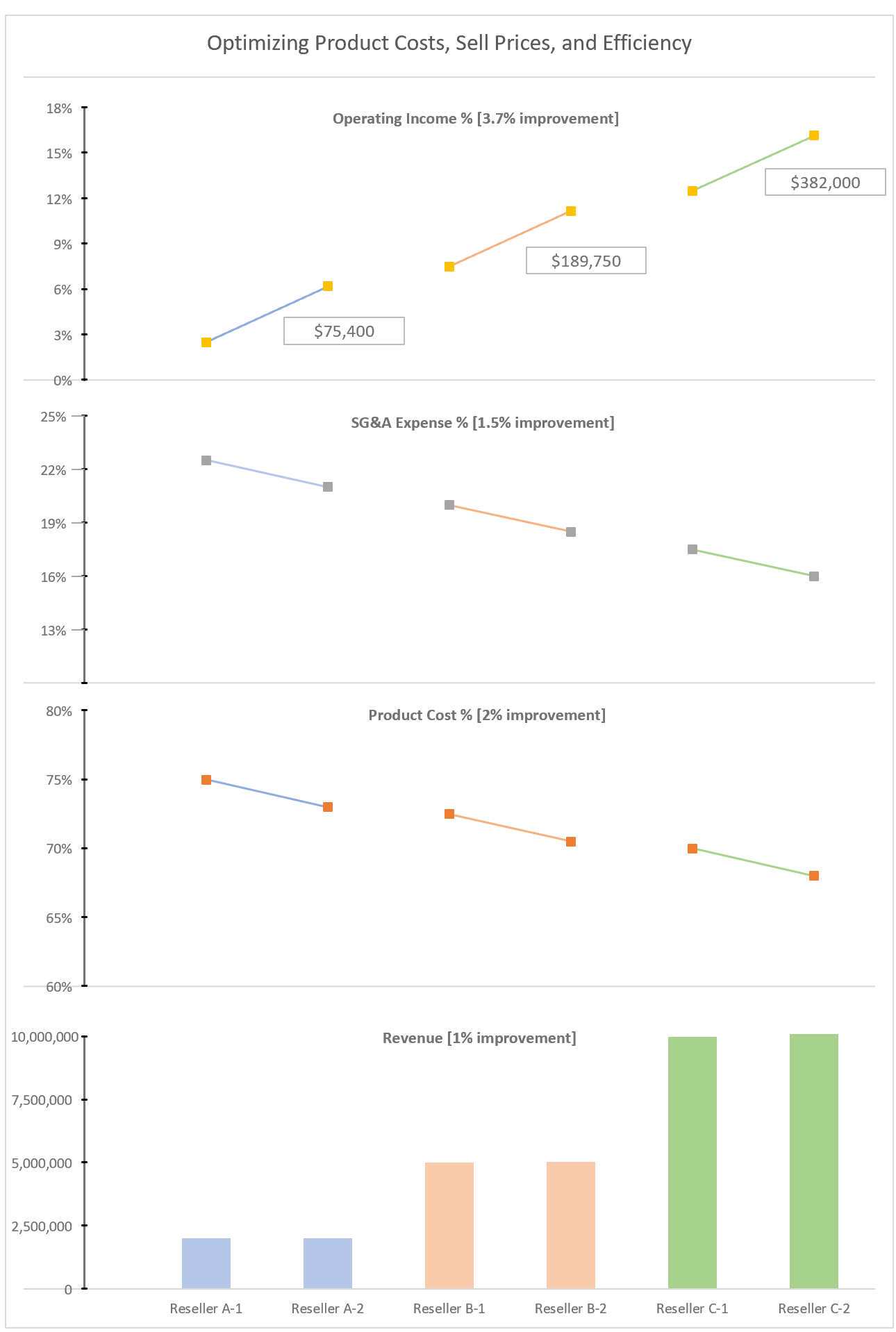
- In implementing market-based pricing on a broad selection of products, not just those from the national wholesalers but also those from a selection of additional vendors, and then using advanced pricing tools to frequently update the entire catalog, it is assumed the reseller can improve sales revenue by 1% without any additional customers or volume.
- Leveraging technology to optimize purchasing decisions and ensure the lowest cost is obtained (from a wider variety of vendors than is typical of most resellers) while also factoring in the cost of freight, handling, and growth rebate programs, it is assumed product cost can be reduced by 2%.
- In utilizing technology for pricing optimization and procurement, and by integrating information technology systems, double-entry data will be eliminated, improving efficiency and reducing costs by 1.5%.
In these examples, the combined impact of the three elements is to improve overall gross margins by 3.7%.
- Reseller A: $2M annual sales - improves operating income by $75,000
- Reseller B: $5M annual sales - improves operating income by $190,000
- Reseller C: $10M annual sales - improves operating income by $382,000
There are several platforms available that have been developed specifically for the office products industry and from which independent resellers may operate their business. They each have their strengths and weaknesses, but most exhibit major flaws when it comes to the data structure underlying the catalog and the integration features that are essential for converting data into actionable business intelligence.
While they may provide a robust solution for customers to transact from, B2B customers are not usually prepared to re-key orders from their enterprise management systems to the resellers, so they transmit their orders in various other forms for the resellers to do the re-keying. For this reason, these legacy platforms accomplish little in traffic generation, brand development, or acquiring new customers.
To access a competitive analysis with a side-by-side comparison of the primary industry platforms, please click the download button.
{{cta('963b79c3-9ac2-4623-8eb9-d23a9caa8308','justifycenter')}}
To learn more about the reseller's value proposition, the technology platform, and the importance of developing web traffic, sign-up for our blog to receive automatic notifications as we publish new, directly related content.
{{cta('b88ab0c9-bb2b-4b70-9cec-9de2995a48a1','justifycenter')}}
Alternatively, please click the following link for immediate access to the complete eight-part series, "Crafting and Promoting the Resellers Business Strategy" or, to learn more about the full scope of this material, and to access in a downloadable e-Book format, please click the cover image below.


